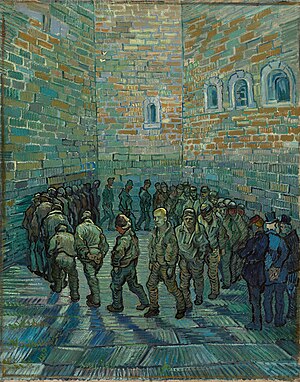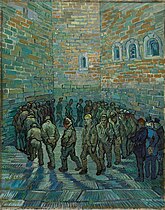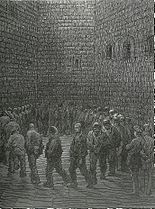Round of prisoners

|
| Round of prisoners |
|---|
| Vincent van Gogh , 1890 |
| Oil on canvas |
| 80 × 64 cm |
| Pushkin Museum , Moscow |
The Round of Prisoners , also known as Prisoners' Tour , is a painting by Vincent van Gogh (1853–1890), made after an engraving by Gustave Doré (1832–1883). It was created in February 1890 in the mental hospital Saint-Paul-de-Mausole in Saint-Rémy-de-Provence , where the painter volunteered in May 1889. The work is one of Van Gogh's late works, it was completed a few months before his death.
Description by Émile Bernard
Vincent van Gogh's fellow painter Émile Bernard (1868–1941) came to his funeral. In the room where he was laid out, the last works, including the round of prisoners , hung . He wrote about it:
“Convicts walking around in a circle, surrounded by high prison walls, a canvas inspired by Doré, from a terrible ferocity, but also symbolic of his end: Wasn't that his life, a big prison like this one with such high walls - like that up ... and these people who go around endlessly in this hole in a circle, weren't they poor artists, poor damned souls, walking past us, under the whip of fate? "
Image content
The painting shows a walled courtyard of a penitentiary , inside a group of almost 40 prisoners walking in circles. The prison yard does not allow a view of the sky, it is surrounded by high brick walls with four small arched windows high above, one of them with bars. The result is a claustrophobic impression. The prisoners pass three detectives who memorize the faces of the criminals.
The painting is dominated by depressing shades of blue and green in the shady depths of the courtyard, with brown spots on the better-lit upper half. Two small white butterflies are already flying near the upper edge . In the lower center of the picture is a prisoner without a cap, whose features resemble those of the painter. He has turned his head slightly, he looks nowhere. The scene is reminiscent of Van Gogh's imprisonment and his mental isolation: alone in a circle, in the midst of people.
Emergence
Van Gogh spent around a year in the Saint-Paul-de-Mausole mental hospital in Saint- Rémy-de-Provence, an earlier monastery from the 12th century. No treatments took place there, most of the fellow patients were inactive all day. He avoided contact with other patients. On the one hand the painter felt like a prisoner there, on the other hand he could paint there without restrictions. A large number of paintings were created. Van Gogh painted motifs from the institution's garden, the view from his window, motifs from the area around Saint-Rémy and also the Starry Night that later became famous . After a severe attack in which he tried to swallow poisonous paints, he made a series of self-portraits .
Towards the end of 1889, the inspiration seemed to wane and the artist began to get bored. Since he could no longer paint plein air , he made a large number of "copies" by other artists, but also replicas of his own work, for example the bedroom in Arles , now intended for his mother or sister. The “copies” are reinterpretations of works whose artist Van Gogh valued and of which he had black and white reproductions on hand: especially by Jean-François Millet (1814–1875), who dedicated himself to depicting farmers and rural life , but also by Rembrandt , Delacroix, Honoré Daumier and just this one engraving by Gustave Doré.
When translating the original in black and white into a color painting, he usually also coarsened the structure and alienated the subject with unusual colors. He wrote to his brother Theo that this work was difficult for him, the work on the prison round (according to Doré) and also that on the drinking men (according to Daumier). The template dates from 1872 and is entitled Newgate Exercise yard . It is one of 180 engravings that Doré created for a commissioned work, the book London: A pilgrimage , created in collaboration with the writer William Blanchard Jerrold .
In the spring of 1890 Van Gogh returned to his irises , but also painted many pictures of roses.
owner
The painting bears the work number F669.
After Theo van Gogh's death in January 1891, the painting was part of the inheritance that his widow Johanna van Gogh-Bonger inherited . The picture came into the possession of the German-Danish painter and art dealer Willy Gretor (1868–1923), then to the French art critic and collector Maurice Fabre (1861–1939) and then to Alexandre Berthier de Wagram (1836–1911). Finally, in 1909, Ivan Morozov (1871–1921), a Russian art collector, bought it. In 1918 his collection was nationalized - as was that of Sergei Shchukin . Both collections formed the basis of the Museum of New Western Painting in Moscow. Morozov and Shchukin left Russia. In 1948 the museum was closed by Stalin , the collections of Shchukin and Morozov were divided between the Pushkin Museum in Moscow and the Hermitage in Saint Petersburg. The Van Gogh painting stayed in Moscow. The inventory number is Ж-3373.
The Moscow Museum owned a total of ten works by Van Gogh, one drawing and nine paintings, including a Memory of the Garden in Etten (Women in Arles) from 1888, now in the Hermitage, and the portrait of Doctor Felix Rey from 1889, now in the Pushkin Museum .
literature
- R. Pickvance: Van Gogh in Saint Remy and Auvers. Metropolitan Museum of Art, 1986, ISBN 978-0-87099477-7 .
Individual evidence
- ^ R. Harrison (ed.): Emile Bernard. Letter to Albert Aurier. Written August 2, 1890 in Paris. van Gogh, J., accessed February 14, 2020.
- ^ Ingo F. Walther : Vincent Van Gogh, 1853–1890, Vision and Reality. Taschen 1986, p: 75.

